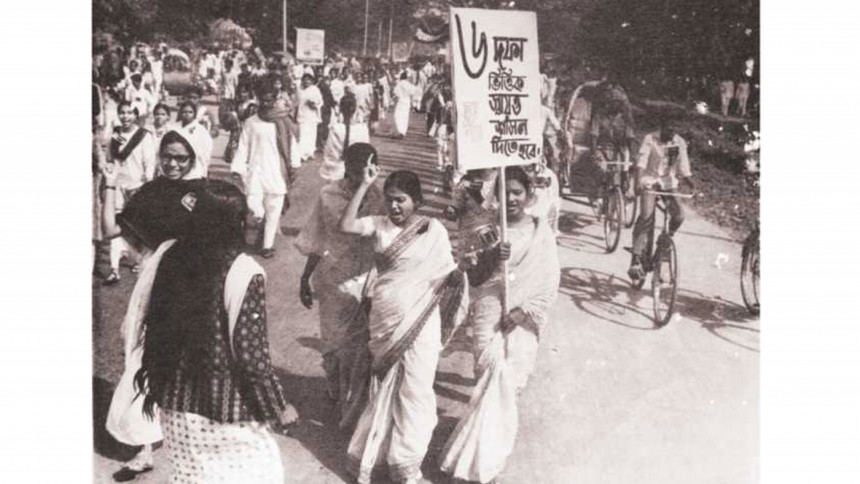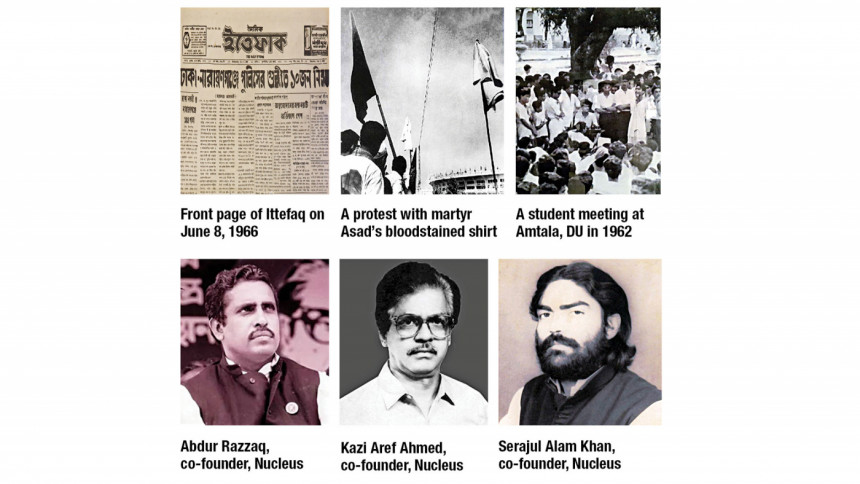Chronicling Bangladesh’s birth: Tumultuous 1960s

Bangladesh's birth was a long and bloody affair. Although an independent Bangladesh was born through the declaration of independence by Bangabandhu Sheikh Mujibur Rahman in the early hours of March 26, 1971, the first seeds of independence were sown decades earlier. Today we run the second installment of a three-part special series that looks back at some of the events in the 1960s that laid the groundwork before the final push for liberation.
In the early 1960s, another covert group codenamed "Nucleus" emerged in the scene to further the cause of an independent Bangladesh alongside the Inner Group, East Bengal Liberation Front, and Apurba Sangsad.
The Nucleus, whose full name was "Swadhin Bangla Biplobi Parishad", was basically a small group within Chhatra League, Awami League's student front.

This group had three main organisers -- Chhatra League general secretary Serajul Alam Khan, deputy general secretary Abdur Razzaq, and its Dhaka metropolitan unit president Kazi Aref Ahmed, according to Mohiuddin Ahmed's "Pratinayak" and Morshed S Hasan's "Swadhinatar Potobhumi: 1960 Doshok".
The idea of Nucleus emerged in 1962, but its formal structure wasn't finalised until 1964. Initially, it focused on strengthening the Chhatra League. Kazi Aref Ahmed disseminated the group's ideology within the Chhatra League, Abdur Razzaq handled member recruitment, and Serajul Alam Khan provided training on political theory to its new members.
Bangabandhu Sheikh Mujibur Rahman sanctioned all Nucleus activities. Upon joining, its members received a leaflet outlining the Nucleus' goals, objectives, and guerilla warfare tactics, according to "Pratinayak".
By 1969, Nucleus committees had already been formed in some 200 police stations across the country.
Dr Mahfuzur Rahman, chairman of Bangladesher Mukti Songram O Gobeshona Kendra Trust, was a member of this group.
"Nucleus operated under a shroud of secrecy. Upon joining, I was explicitly told that member identities were on a strict need-to-know basis. I would only know the identities of the members I would bring in as part of a small-scale recruitment programme in Chittagong," he told The Daily Star last week.
Also speaking to this newspaper, writer and researcher Morshed S Hasan said Nucleus initially operated through Chhatra League.
"While some information on other secret organisations involved in the independence movement was known at the time, the role of Nucleus only came to light after independence," he said.
1965 INDO-PAK WAR
In September 1965, war broke out between India and Pakistan. This conflict, centred around Kashmir, would have a lasting impact on the region.
East Pakistani soldiers, despite facing neglect and oppression by West Pakistan, demonstrated great courage in the war.
However, East Pakistan itself remained extremely exposed during the 17-day war.
"While some in East Pakistan expressed anti-Indian sentiment during the 1965 Indo-Pak war, the vulnerability of the region itself wasn't a widely-discussed topic at the time. However, during the political campaigns of 1966, the issue of East Pakistan's lack of military preparedness gained significant traction," writer and researcher Afsan Chowdhury told this newspaper.
SIX-POINT MOVEMENT
The fight for independence found a crucial turning point in the form of a six-point demand. Seen as one of the most significant steps towards freedom, these demands laid the groundwork for East Pakistan's autonomy.
In February 1966, a two-day Pakistan National Conference was held in Lahore to discuss regional matters.
On the second day of the conference, Mujib unveiled his six-point proposal for East Pakistani autonomy, which was met with resistance.
So, along with colleagues, he boycotted the meeting.
Upon returning to East Pakistan on February 11, 1966, Mujib presented his six points at a press conference in Dhaka.
The demands were: 1) formation of a federal government where power is shared between the central government and the provinces, 2) The central government would only handle defence and foreign affairs of the provinces. All other matters would be controlled by the provinces, 3) East and West Pakistan would have their own currencies, 4) Each province would collect its own taxes and manage its own industries, 5) Each province would control its own foreign trade and manage its foreign exchange reserves, and 6) Each province would have the right to form its own paramilitary force.
On March 19-20, 1966, Awami League formally adopted and approved the six points as their official programme. Following the announcement, Mujib embarked on a nationwide tour to garner public support for the six points and faced multiple arrests throughout this period, according to Oli Ahad's book titled "Jaiya Rajniti 1945-1975".
In protest of Mujib's arrest on May 8, 1966, following a public meeting in Narayanganj, Awami League called a general strike across East Pakistan for June 7. At least 10 people, including six in Narayanganj, were killed in police firing that day. Daily Itttefaq ran a front-page news on the police shooting.
Three days later, its Editor Tafazzal Hossain Manik Mia was arrested for supporting the six points.
The Pakistan government also sought to shut down the paper by confiscating its printing press, but the move failed in the face of a court ruling.
"Regardless of how we view the freedom struggles of the 1950s and 1960s, the six points laid the main foundation of Bangladesh's independence movement. This proposal brought the issue of independence to the forefront," writer and researcher Mohiuddin Ahmad said.
1969 MASS UPRISING
Pakistan responded to the six-point demand by launching a crackdown and accusing Mujib and other prominent Bangalee figures of treason. These figures included military officers, politicians, and government officials. The case is commonly known as Agartala conspiracy case.
On January 6, 1968, the government issued a press release announcing the arrest of 28 military personnel and civilians on charges of plotting against the state in collaboration with the First Secretary of the Indian High Commission in Dhaka.
The case meant further imprisonment of Mujib, who was set to be released on January 17, 1968, from jail where he had been since May 1966, according to multiple books including Oli Ahad's "Jatiya Rajniti 1945-1975".
Instead of releasing him, the Pakistan government took him to Dhaka cantonment, listing him as the prime accused in Agartala conspiracy case.
The trial against Mujib and 35 others began in June 1968 in a special tribunal set up inside the Dhaka cantonment.
The six-point demand had already ignited a fire of desire for autonomy in East Pakistan. The Agartala conspiracy case, seen as a blatant attempt to suppress dissent, only served to fuel public outrage.
"Discontent simmered among Bangalee officers and soldiers in the Pakistani military due to discrimination. These personnel began organising and working towards East Pakistan's independence. News of an underground movement led to the arrest of around 1,500 Bengalees. This incident provided the Pakistani military government with an opportunity to build a case against Sheikh Mujib, specifically tying it to his calls for autonomy in his six-point demand," Afsan Chowdhury told The Daily Star.
On December 6, 1968, following a mass gathering at Paltan Maidan, a procession led by Maulana Bhasani marched towards the Governor's House and was met with police beating, according to Oli Ahad's "Jatiya Rajniti 1945-1975".
After the tumultuous first two weeks of January 1969 marked by a series of protests, police action and ban on public gathering, the general strike called by Chhatra Sangram Parishad for January 18, 1969, marked a tipping point. A wider protest quickly spread across the region.
Two days later, the movement took a tragic turn. Asad, a student of Central Law College, was fatally shot by police during a procession. Outraged, protestors took to the streets, defiantly carrying his bloodied shirt. Dhaka turned into a city of processions calling for justice.
Desperate to quell the growing unrest, the administration imposed a 24-hour curfew starting 8:00am on January 24, 1969. But it failed to contain the protesters.
At a street protest defying the curfew on January 25, Pakistan army opened fire, killing Dhaka Polytechnic Institute students Abdul Latif and Anwara Begum, according to Dr Mahfuzur Rahman's "Bangali Jatiyotabadi Andolon O Muktijuddho".
Their deaths further stoked the movement's flames.
Fierce protests continued in February 1969 that saw the deaths of Sergeant Zahurul Haque in Dhaka Cantonment and killing of Rajshahi University Professor Dr Mohammad Shamsuzzoha in front of the university's main gate.
In the face of the mass agitation, the Pakistan government was forced to drop the Agartala conspiracy case and unconditionally release Mujib and all other accused on February 22, according to Dr Mahfuzur Rahman's "Bangali Jatiyotabadi Andolon O Muktijuddho", and Oli Ahad's "Jatiya Rajniti 1945-1975".
The next day, an estimated 10 lakh people gathered at the historic at Race Course Maidan to celebrate Sheikh Mujib's release.
At this very rally, organised by Chhatra Sangram Parishad, veteran Awami League leader and then Ducsu president Tofail Ahmed bestowed upon Sheikh Mujib the title of "Bangabandhu".
"Though the 1969 mass uprising was a collective effort, Bangabandhu's firm leadership positioned the Awami League at the forefront of the movement," said Dr Mahfuzur Rahman, who was a member of Nucleus.


 For all latest news, follow The Daily Star's Google News channel.
For all latest news, follow The Daily Star's Google News channel. 










Comments